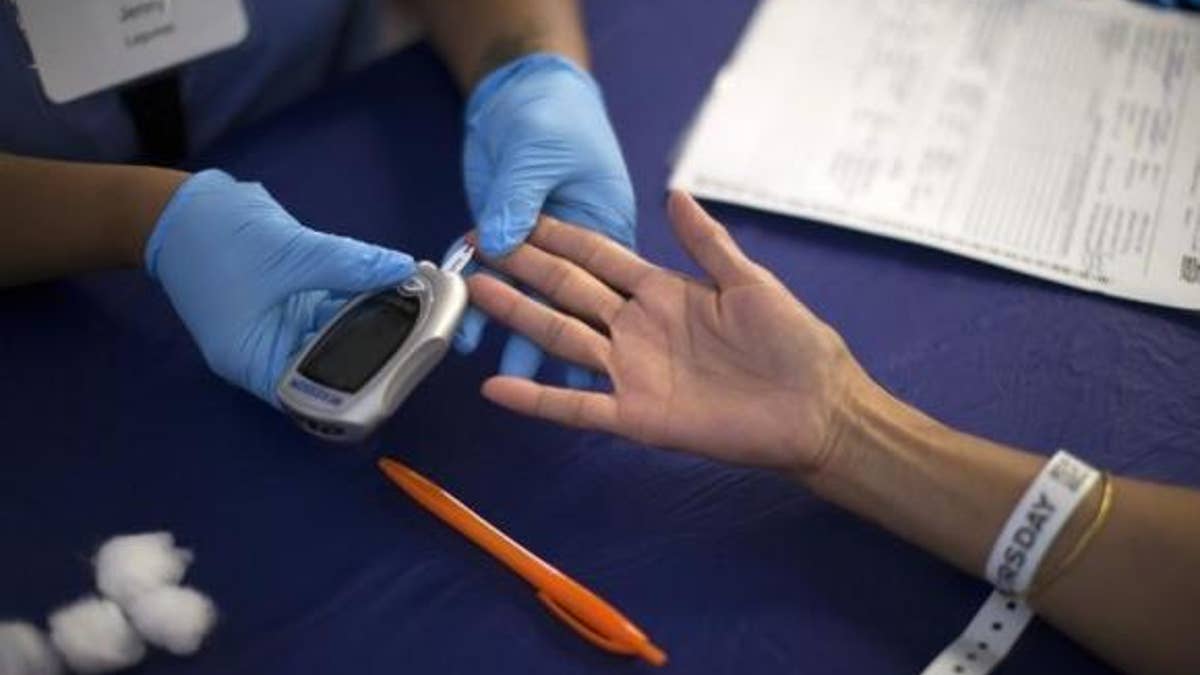
Sept. 11, 2014: A person receives a test for diabetes during Care Harbor LA free medical clinic in Los Angeles, California. (Reuters)
People with type 1 diabetes are more likely than the general population to develop cancers of gastric organs and the kidneys, as well as endometrium and ovaries for women, according to a large new analysis.
But the authors also found that other sex-specific cancers, including prostate and breast, were significantly less common among people with type 1 diabetes.
Diabetes has been tied generally to increased cancer risk in the past, but studies have relied mostly on data from people with type 2 diabetes, which develops slowly, usually in adults who are overweight or obese, and affects about 28 million Americans.
Type 1 diabetes, typically diagnosed in children and young adults, affects about 1.25 million Americans, according to the American Diabetes Association.
"People with diabetes and (those with) cancer have many common risk factors, including obesity, poor diet, physical inactivity and smoking," said study coauthor Jessica H. Harding of the Baker IDI Heart and Diabetes Institute in Melbourne, Australia.
However, "the overall excess cancer risk among type 1 diabetes is moderate," Harding told Reuters Health by email. "People with type 1 diabetes should not be alarmed about the results from this study but follow current guidelines for cancer prevention and participate in national screening programs as per the general population."
The researchers analyzed data from national registries of people with type 1 diabetes in Australia, Denmark, Finland, Scotland and Sweden through 2008 or 2012, and linked these records to national cancer registries.
There were 9,149 first incidences of cancer in the diabetic patients they identified, half of which happened before age 51. Compared to the general population for the same time period, men with type 1 diabetes had a similar rate of cancer diagnosis overall, and women with type 1 diabetes were about seven percent more likely to be diagnosed with cancer.
Cancers of the stomach, liver, pancreas, endometrium and kidney were about 25 percent to 50 percent more common among people with type 1 diabetes, though breast cancers were 10 percent less common and prostate cancers were 56 percent less common, as reported in Diabetologia.
The researchers found the biggest risk increase for liver cancer in men, which was twice as common in those with type 1 diabetes, and 78 percent more common in women with diabetes.
Liver cancer occurs at a rate of 7.5 cases per 100,000 people each year in the U.S., according to the American Cancer Society. So, even doubled, the overall risk remains low, the researchers note.
"The risk of some cancers is altered slightly among people with type 1 diabetes but not enough to cause serious concern," said Sarah Wild, who researches diabetes and cardiovascular disease at The University of Edinburgh in Scotland, and is also a coauthor of the new study.
"One question that the work addresses is whether long-term insulin treatment increases the risk of cancer and the good news is that there does not appear to be a strong effect," Wild said.
But the pattern of cancers is similar to that seen with people that are overweight or have type 2 diabetes, although the changes in risk are smaller, so weight may play a role, she told Reuters Health by email.
"The apparent reduction in breast cancer among women with type 1 diabetes needs confirming but may be related to different patterns of child-bearing," she said.
Cancer risk was highest shortly after diabetes diagnosis.
"This could happen if the cancer caused symptoms that meant people received a test for diabetes before the cancer was diagnosed, because liver and pancreatic cancers can cause diabetes and also because people with newly diagnosed diabetes will be seeing doctors and nurses frequently and so may report symptoms and get cancers picked up earlier than people without diabetes," Wild said.